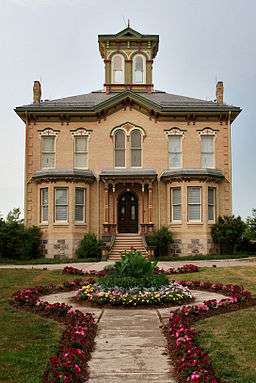Castle Kilbride
| Castle Kilbride | |
|---|---|
|
Castle Kilbride, Baden, ON | |
| Location | Baden, Regional Municipality of Waterloo, Ontario, Canada |
| Elevation | 354 metres (1,161 ft) |
| Built | 1877 |
| Original use | Residence of James Livingston |
| Website | Historic Castle Kilbride |
| Designated | March 1994 |
Castle Kilbride is the former residence of James Livingston, a Canadian member of parliament, and owner of flax and linseed oil mills. It was designated a National Historic Site of Canada in March 1994.[1][2]
It was built in Baden, Ontario in 1877 and named after Livingston's birthplace in Scotland. The major feature of Castle Kilbride is the interior decorative murals in the style of the Italian Renaissance. The trompe-l'œil technique used in the murals gives the illusion of a third dimension. The building is also an outstanding example of an Italianate villa of its place and time, and at the time of its building was a tribute to the reputation of its owner as the so-called 'Flax and Oil King of Canada'.
History
The original owner of Castle Kilbride was James Livingston. He was born in Scotland November 28, 1838.[3] James Livingston moved to Canada from Scotland around the age of 16.[4] When he arrived in Canada he hardly had a penny to his name. He ended up staying in the town of Baden. He started working with his older brother John to earn simple wages to keep themselves. After a while the brothers pooled enough money to start a small flax farm. In 1861, James Livingston married Louise Liersch. To make the processing of flax cheaper the brothers built a flax mill in 1863 and in 1864. Over the course of a little more than ten years James and John got about fifty five tons of flax seeds. He chose a good crop to grow due to the fact that at 1871 there was a call for different linens than cotton. This was due to the civil war in America causes massive devastation to cotton farms. The reason that James Livingston was able to build Castle Kilbride was due to one of the ways that flax seeds can be used for. Flax seeds can be used in hemp for clothing and in linseed oil. Castle Kilbride was built due to the selling of linseed oil. The second mill that was built in Baden during the 1874 year was used to produce linseed oil. When the production of oil paints included linseed oil to add to its quality the Livingston brothers made the ‘J&J Livingston Linseed Oil Company’. By 1881 the Livingston brothers had more than 3000 acres that were being used for flax farming. James Livingston built Castle Kilbride. The house was built in 1877, which is also the year that James Livingston was elected Reeve of the Township of Wilmot. James’s older brother died in 1896 making him the head of the entire business. Mr. Livingston often looked into innovations of technology, such as the automobile. Eventually the operation of the Baden Linseed oil mill went to his son, John Peter. Every year after James Livingston’s retirement there was a picnic held for all of the company employees along with their families. Upon the death of Livingston, their son, John Peter, his wife Laura, and their daughter Laura Louise moved into Castle Kilbride. John Peter continued to meet the approval of the employees as a good man. The Livingston oil company began to decline at the invention of latex paint. Castle Kilbride was not sold to the Township of Wilmot until 1993.[3]
Building
The construction of Castle Kilbride took about one year to complete. It was constructed by a local man known by the community as David Gingerich. Castle Kilbride was completed around the year 1878. One thing that James Livingston did with the design was made the front lawn in the shape of a heart to show tribute to his love to his wife, Louise.[5] The castle ended up consisting of over 10,000 square feet of living space. It also had the approximate dimensions of 44 feet wide, 42 feet deep and 44 feet high. The residence is three stories tall and has undergone changes over the course of time. Castle Kilbride today contains a mixture of all sorts of items that were housed in it all the way to the time that it was sold to the Township of Wilmot in 1988. However, the actual paintings that are displayed on the walls are original and are considered to be a part of art known as trompe l’oeil, which means “fool the eye”. The only known major addition to the Castle was done in 1920. This is when John Peter expanded a storage area to make the summer kitchen. The Township of Wilmot did not start the restoration of the Castle until 1993. The next year it was made a Historical site.[3] Some of the items that are displayed in Castle Kilbride include original furniture, and household items. In the year 1994, Castle Kilbride was declared a National Historic Site. Castle Kilbride is located in the city of Baden, Ontario. The exact address of Castle Kilbride is 60 Snyder's Road West.[6]
References
- ↑ Castle Kilbride, Directory of Designations of National Historic Significance of Canada
- ↑ Castle Kilbride. Canadian Register of Historic Places.
- 1 2 3 "Canadian Castles Part 3: Castle Kilbride". History to the People. Retrieved 29 September 2012.
- ↑ "Castle Kilbride Baden- Restoration". Waterloo Regional Heritage Foundation. Retrieved 29 September 2012.
- ↑ "Livingston Dreams: A historic bridal fashion show at Castle Kilbride" (PDF). Castle Kilbride. Retrieved 29 September 2012.
- ↑ "Castle Kilbride". Virtual Museum Canada. Retrieved 29 September 2012.
Bibliography
- Brown, Ron (2005). Top 100 Unusual Things to See in Ontario. Erin, ON: Boston Mills Press. pp. 196–197. ISBN 978-1-55046-475-7. OCLC 154683557.
External links
Coordinates: 43°24′15″N 80°40′17″W / 43.40417°N 80.67139°W
